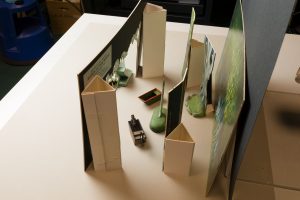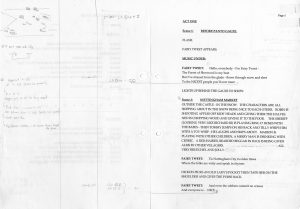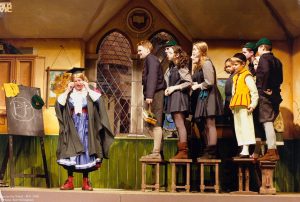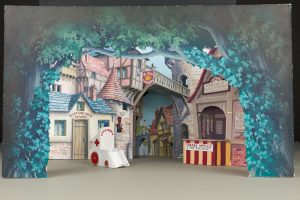Theatre is a collaborative art form. It takes a whole team of people to take a play from page to stage. All too often though, we only pay attention to the people performing onstage. Those who work backstage go unseen by the audience, and it is difficult to know just what they do, and what career opportunities exist.
Using Bristol Old Vic’s archives held at the University of Bristol Theatre Collection, Making A Scene (funded by the Museums Association Digital Innovation and Engagement fund) aims to fill this knowledge gap by giving young people across Bristol the chance to peek behind the curtain….
These blogs, written by staff involved in the project from the University of Bristol Theatre Collection, Bristol Old Vic and Zubr, a Bristol based Augmented Reality and Virtual Reality studio, are a behind the scenes look at the process of creating this behind the scenes resource.
 Model box designed by Colin Winslow, Babes in the Wood, Bristol Old Vic Company (2000). MODEL/84
Model box designed by Colin Winslow, Babes in the Wood, Bristol Old Vic Company (2000). MODEL/84
At Bristol Old Vic, I share an office with our stage management team. When we were discussing what Making A Scene should look like, I began to notice that at their end of the office the answer to almost any question about a particular production was “check in the book”.
The book they were referring to was the prompt script. It contains all the information necessary to stage a production: the script marked up with blocking and cues; a scenic design plan; costume design sketches; lists of props; and lighting, sound, and special effects cues.
 Prompt script, Babes in the Wood, Bristol Old Vic Company (2000). BOV/3/2/732/1/1
Prompt script, Babes in the Wood, Bristol Old Vic Company (2000). BOV/3/2/732/1/1
A good prompt script is a record of the work and skill of the creative and backstage teams, which is exactly what we wanted Making A Scene to be. Our stage management team had unknowingly given us the perfect frame to build our resource around (they have been thanked with biscuits since). All we had to do was find some exciting content to put in it.
The Bristol Old Vic Company archive at the Theatre Collection has nearly 1,000 (or equivalent) boxes of material, so we certainly had plenty of options. Because of the incredible breadth of material at our disposal, we originally considered making a mash-up prompt script which showcased several iconic Bristol Old Vic productions.
However, the more time we spent researching, the more it became clear that it was a much stronger idea to focus on a single production. I wanted everyone using Making A Scene to have the same experience I had in the reading room of seeing a production come to life before my eyes. To see a sketch transform into a model box (a scaled-down 3D model of what the designer thinks the set should look like) and into a finished piece of set, and so on.
Making a final decision as to which production this would be was probably the most exciting and the most frustrating part of the research process. Archives are spaces of gaps and silences and every production we considered seemed to be missing something. A production with a beautiful model box and a detailed lighting plan didn’t have costume sketches or technical details. A production with detailed stage plans and rehearsal notes had no set designs or model box. Our search went on and on.
After a lot of looking, we managed to find two strong options. Henry V from 1964 and Babes in the Wood from 2000. The final decision came down to the richness of the material to hand and the emotional resonance of the production. Babes in the Wood was the final pantomime staged at Bristol Old Vic and we all felt that choosing a pantomime would inject a sense of fun to the project development as well as the end product.
 Production photograph by Bob Willingham, Babes in the Wood, Bristol Old Vic Company (2000). BOV/3/2/732/6/3
Production photograph by Bob Willingham, Babes in the Wood, Bristol Old Vic Company (2000). BOV/3/2/732/6/3
The prompt script for Babes in the Wood also documents every minute stage of the production process. You get a sense not just of what every backstage role involves, but the day-to-day reality of doing it. Beautiful set design sketches sit side by side with notes scrawled on scraps of paper asking someone to give them a ring when they get back from lunch.
 Model box designed by Colin Winslow, Babes in the Wood, Bristol Old Vic Company (2000). MODEL/84
Model box designed by Colin Winslow, Babes in the Wood, Bristol Old Vic Company (2000). MODEL/84
The prompt script is also accompanied by a phenomenally detailed model box with multiple cloths, wings, trucks, and props which we knew could form the perfect basis for a truly immersive augmented reality experience. Sarah, the digitisation officer at the Theatre Collection, and Zubr had the same head over heels reaction to the possibility of 3D scanning and augmenting each individual piece that I had to the possibility of reproducing the prompt script. Sarah will be blogging about her process to create 3D digital models later on.
Such was the richness of the material that by the time we began to put the final resource together I think everyone involved felt like they had seen Babes in the Wood. My hope is that everyone using the resource feels the same!
